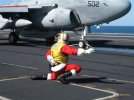So after completing jet training in the TA-4... you still had to go through the A-4 RAG?
Affirm.
It was called the "Instrument RAG" in its pre-Adversary days ... it was more "intensive" than the TRACOM -- for instance, it was the first time you took off in the aircraft under the bag from zero airspeed to trying to level off and transition to maintain 250 KIAS on SID Seawolf ... complete w/tons of GCA's and non-precisions @ San Clemente, Miramar, NORIS, and potentially any and all Navy, Marine, and Air Force fields in California.
No real syllabus as such that I can remember ... you just kinda' did what everyone else was doing or what your Instructor of the day felt like doing.
*edit* ... both TA-4 and TF-9 newly winged Aviators went through TA-4's in the VF-126 "Instrument RAG", NOT the A-4 RAG up in Lemoore ... obviously, the transition was a little easier on the former TA-4 STUDs as we'd accumulated @ 100 hours in type by the time we showed up. I know there were always exceptions, good-bad-and ugly .... but the former Cougar drivers had more "trouble" in my class and tended to get a few extra times. No downs ... just some more time, mainly for proficiency.

















